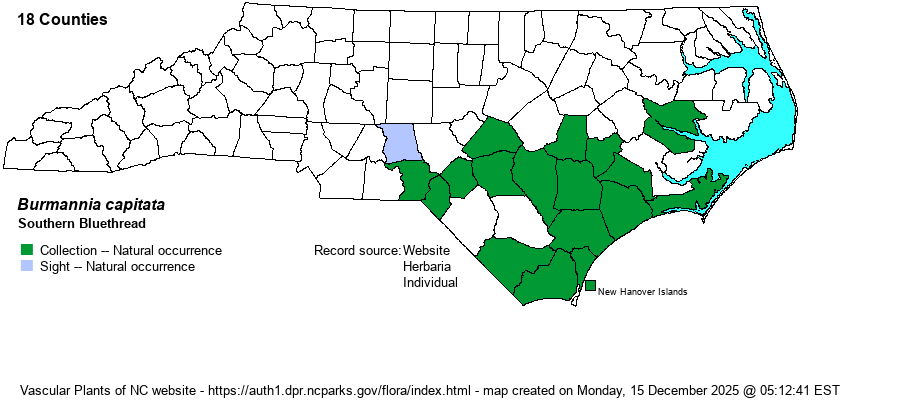| Author | (Walter ex J.F. Gmelin) Martius | |
| Distribution | Present over most or all of the southern half of the Coastal Plain, ranging north to Beaufort, Wayne, Harnett, and Montgomery counties.
This species ranges from eastern NC south to southern FL and west to central TX. It also occurs southward to South America. | |
| Abundance | Infrequent in most of the range, being most often found in Longleaf Pine regions from Carteret to Brunswick. Quite uncommon and local in the Sandhills region and other counties inward from the coast. | |
| Habitat | Both species of Burmannia occupy very similar habitats in NC, and they can occasionally be found around the same pool or pond margin or sandhill seep. As it is a tiny species, it requires little other competition and generally full sun, being a denizen of savannas, seeps, margins of various ponds and pools, margins of impoundments, and other damp open ground. However, as with B. biflora, most sites are in natural settings and not at ditches or scrapes. | |
| Phenology | Blooms and fruits from July to November. | |
| Identification | This is a very small species, with a thin, wiry stem that grows only to about 3-4 inches high, and contains a few easily overlooked scale-like leaves along the stem. At the top of the stem is the flowering "head" -- a dense cluster of tiny white flowers, often 10-12, each appearing like a narrow white tube, growing in all directions to form a "spiky-ball". Each flower is only 1/4-inch long and barely 1/10-inch wide. Because the colored portion visible at any range is the ovary, when in fruit the plant looks essentially the same as when in flower. As with B. biflora, you must get down on your knees or belly to see it or photograph it well. This species is somewhat more widespread than B. biflora, though it is still infrequent and easily overlooked; walking in savannas and other natural areas may get you a glimpse of it, though as with that species it does not generally grow in colonies. With each species, just be glad you encounter a few individuals and congratulate yourself for being attentive to such tiny but most unusual plants! | |
| Taxonomic Comments | None
| |
| Other Common Name(s) | White Burmannia | |
| State Rank | S3? [S3] | |
| Global Rank | G5 | |
| State Status | | |
| US Status | | |
| USACE-agcp | OBL link |
| USACE-emp | OBL link |

